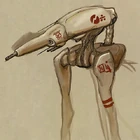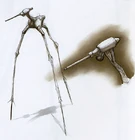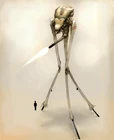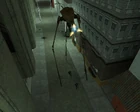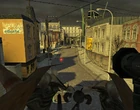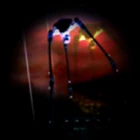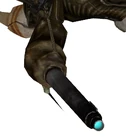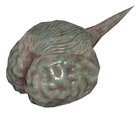| The subject of this article is featured in the new Half-Life: Alyx; therefore, its content is subject to change as more information about it is added. |
| To illustrate the article add one or more relevant images or upload them from canonical / official sources. For more instructions visit Half-Life Wiki:Images. |
- "Oh my God... Striders really tore the hell out of this place..."
- ―Alyx Vance[src]
The Strider is a large three-legged arthropod-like Combine Synth, armed with both a pulse minigun and warp cannon on its hull. Introduced in Half-Life 2, they serve as the Combine's main heavy ground assault unit.
Overview[]
Striders are capable of pursuing hostiles in both confined streets and open plazas, even crouching down to fire at enemies who seek cover under overhangs or in bombed-out buildings.
The Strider's body is covered in a smooth brown carapace or exoskeleton. On the "head" of the Strider is a rapid-firing pulse cannon, with a heavier warp cannon suspended below. The three long legs of the Strider are tipped with sharp spikes and a rosette of finer, hair-like spines.
While walking about or attacking, Striders produce many different vocalizations, such as growls, groans, whoops, and howls; when killed, they let out a mournful cry. In addition, Striders will leak a yellow substance when their interior is damaged, and their carapace contains a large, somewhat human-looking brain.
According to Ted Backman, Striders that are seen on Earth are not biological creatures with cybernetic implants but, rather, synthetic copies of their natural counterparts that were retrofitted for the needs of the Combine. Backman states that Striders are scanned in their natural environments by the Combine and the data acquired is used to build their synthetic version that is used for the Combine war machine, as well as maintenance and building.
Construction Strider[]
A new variant of the Strider is introduced in Half-Life: Alyx; this version, however, possesses no offensive capabilities and was redesigned to aid in engineering and maintenance.
A Construction Strider possesses a mechanical platform attached to their main body, from which Combine Workers operate. The platform consists of three devices; a mechanical torch arm, which is used for welding work; binoculars, and a machine of unknown function, all of which are operated by Combine Workers. Mechanical legs connecting the platform to the strider also keep the platform levelled and prevent Workers from falling off.
Constructions striders were modified in several ways; their legs have been enhanced with augmentation devices to aid with roof climbing and improve balance, their warp cannon was replaced with a connector; which is used to move and connect large cables to Combine devices on rooftops, as shown in the first section of the game; and their pulse cannons were also replaced with a single large robotic eye.
Construction striders appear to have a very firm and heavy walk, apart from the more soft and slow walk from normal striders, this behavior may be due to the augmentation devices attached to their legs. They are observed to cause infrastructural damage as they walk.
Application[]

A Strider among City 17 rubble.
Prior to the Uprising, Striders are often seen patrolling the streets of City 17. After the Resistance fully declared open war in the City, Striders showcase their full capabilities as heavy support for Overwatch soldiers, using their front-mounted pulse gun to pick-off rebels quickly. Striders also function as artillery by using their warp cannon to destroy all structures in an area as a means of removing all entrenched hostile forces. Striders have remarkable maneuverability despite their size and are also able to squeeze into and clear out tunnels by extending their legs wider apart and lowering their body. In this position, Striders can move exceedingly fast due to weight being spread out and their center of gravity lowered, and can move through tunnels quickly or sprint across open battlefields while firing at enemy positions.
In wilderness areas, Striders are often accompanied by Hunters which act as escorts to destroy smaller targets and potential threats to the Strider. During the Combine offensive against White Forest, Striders are used to destroy the outer buildings surrounding the Resistance base, including the Magnusson Device teleporters.
Striders can be transported to and from combat zones by Combine Dropships. When being transported, they will fold their legs into a compact shape that allows them to be carried.
Weaponry[]
Striders are armed with two ranged weapons. The first is an anti-personnel pulse cannon mounted on the front of the Strider's carapace. The pulse cannon seems to be the Strider's eye as it twitches around sporadically as if constantly surveying its surroundings. The second (and by far the more powerful) weapon is a warp cannon mounted on the Strider's belly under the pulse cannon. This cannon not only causes scenic destruction but also inflicts massive splash damage that will vaporize anything in proximity to the area of impact. Prior to the warp cannon's discharge, a thin blue laser indicates where the Strider is aiming at and the space around the weapon becomes warped, bending light as the cannon charges. They are strong enough to kick vehicles into the air. Besides using ranged weapons, Striders can impale targets with their long legs, any target that is impaled will die instantly, if they come too close. When a target is impaled while still on their legs, the Strider will swing its legs to "drop" the target's corpse.
In Half-Life 2, the Strider's pulse cannon does a large amount of damage - approximately 20 to 30 per shot. However, it is programmed to only hit with the last few shots, giving the player time to seek cover. In Episode One, the Strider's pulse cannon is far more accurate and has a faster (but variable) rate of fire, but in order to balance gameplay, inflicts a fraction of the damage (approximately 5 to 10).
Appearances[]
Half-Life 2[]
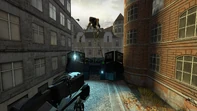
A Strider as seen for the first time in Half-Life 2.
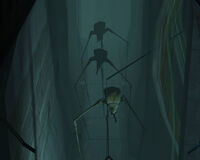
Striders walking in the Citadel.
In Half-Life 2, the Strider is first glimpsed walking along a barred street with a City Scanner some time after leaving the Trainstation Plaza.
The Strider is seen again much later in the game, during the chapter "Follow Freeman!", during the Overwatch Nexus battle. There Gordon must defeat several Striders, helped by other Rebels, firing with their RPGs from the ground and the rooftops. Soon after, a Strider confronts Gordon who tries to hide in a building. This is where the Strider is seen working with Shield Scanners that always reveal Freeman's presence to the tripod wherever he tries to hide.
Right after that building, Gordon finds himself into another battle and must defeat Combine soldiers and Striders with other Rebels. After defeating all Striders, Gordon reunites with Barney and Dog and enters the Citadel.
Within the Citadel, an onslaught of Overwatch Soldiers, Elites and a Strider fought Gordon Freeman in an attempt to halt and prevent him from reaching Dr. Breen. While riding through the Citadel to Breen's Officer, several Striders were seen on their way, likely being deployed into the battlefield against The Resistance.
Half-Life 2: Episode One[]
In Episode One, the first Striders can be seen walking through the Citadel to an unknown location, not noticing the two characters. Not long after, Gordon and Alyx see a damaged Dropship carrying a Strider arriving just beneath them, only to crash a few seconds later.
Another Strider is seen when they leave - at last - the City 17 Underground and see that Kleiner has taken over the Breencast network. There a Strider is seen from afar walking among rubble and does not notice them.
Later at the Technical Trainstation, a Strider and several Overwatch Soldiers attempt to prevent Gordon and Alyx from leaving the city, the Strider acting as the game's final boss. The player will be required to defeat this Strider with an RPG. After successfully defeating it, Gordon and Alyx finally leave City 17 via train. However, if you defeat it before a certain point in this section, another Strider will spawn in. It will continue to endlessly spawn in Striders up until a certain point in the level, before you hop onto the train.
Half-Life 2: Episode Two[]
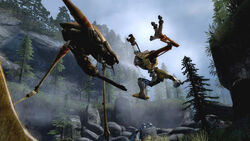
Dog about to prove his value against a Strider, as seen in the Episode Two trailer.
In Episode Two, Striders are first seen among a Combine convoy walking to White Forest.
Some time after, at a short distance from White Forest, Gordon and Alyx's way are barred by an apparently dead Strider. It wakes up and rises to its feet, leaving the characters in a dangerously vulnerable situation, but Dog emerges from the tree line and jumps at it from high ground. A spectacular battle ensues, ending when Dog tears the plates off the Strider's head to access its vulnerable internals, and forcibly removes the creature's brain.
Striders are last seen during the White Forest battle, where they threaten the rocket's launch, aided by Hunters. To defeat them, Freeman must use the Magnusson Device, or Strider Buster, introduced by Arne Magnusson. It is a specially designed bomb intended to be flung at the Strider's main body with the Gravity Gun whereupon it attaches itself through the means of conductive spikes, after which it can then be detonated by firing on it with a conventional firearm. The detonation of a single properly employed Strider Buster is sufficient enough to destroy a Strider. During the battle, the Striders destroy many of the surrounding buildings. After Freeman has taken them all down with the Strider Busters and the help of the other Rebels, the rocket can be successfully launched into space.
Half-Life: Alyx[]
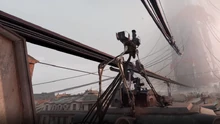
Multiple non-hostile Striders make an appearance during the first section of Half-Life: Alyx.
- A Strider is first seen in the background from the platform that Alyx initially spawns on, along side multiple Hunter-Choppers.
- Later on, whilst atop the adjacent balcony, a Strider can be seen mounting a rooftop and plugging in a combine cable. This damages the clay shingles closest to Alyx.
- On the catwalk above the a playground based off that from Half-Life 2, a Strider passes down the street, destroying Russell's drone.
After crashing the Vault and while looking for a way in, Alyx encounters two Combine Soldiers standing next to an apparently de-activated Strider, with one of the soldiers trying to kick it to wake it up again, only for Overwatch to tell him to stop. Alyx dispatches the soldiers and confirms the Strider is not working: Russell remarks that it would be terrible if it came back to life. This jinxes it, as moments after Alyx reactivates a power generator for an elevator, the Strider abruptly comes to life and begins chasing her through the wreckage. After fighting off some more Combine soldiers while evading the Strider, Alyx discovers a Combine gun which she uses to destroy it.
Tactics[]
- Striders tend to follow specific patrol routes when tasked with defending a certain area, making them fairly easy to avoid. However Shield Scanners sometimes accompany them, functioning as spotters for the Strider, searching inside buildings and other places of concealment for targets the tripod would otherwise be unable to see. However this symbiont behavior between the two Synths is only seen after the Overwatch Nexus battle.
- Due to their incredibly high damage output and pinpoint accuracy on their last few hits, cover plays an extremely important role while fighting Striders. Often, instead of fighting in the open, one is much less likely to die while only running out of cover when running to another spot or when launching a rocket. However, in Episode One and Episode Two, the damage is lowered but taking cover is still important.
- Striders will often use their warp cannon when the target is behind cover. Therefore, the player should leave cover immediately after the sound is heard.
- Striders are often rather unaware of their opponents - this is most obvious during the battle outside the Overwatch Nexus. This can be exploited to avoid a lengthy and hazardous battle against many partially avoidable Striders, since when only one or two Striders remain, they can be bypassed.
- After the Magnusson Device, the most powerful weapon against Striders, the RPG is the most efficient weapon, as its rockets do the most damage, though it takes 5 rockets just to kill one in Easy mode. Grenades, MP7 grenades, and Energy Balls do about half the damage of a rocket. Unlike Gunships, which can snipe flying rockets, Striders tend to ignore all projectiles launched at them, focusing on attacking the player instead.
- Using the Magnusson Device against a Strider is not advised until all nearby Hunters are defeated, as they will fire at the device as soon as they see it.
- On harder difficulties, Striders tend to duck flying rockets, which should be anticipated when firing.
- In some cases, one or more Striders usually have to be destroyed in order to make further progress in the game, often acting as 'bosses'. If the player doesn't follow this order in Half-Life 2, the Strider will fire their warp cannon directly at the player.
Behind the scenes[]
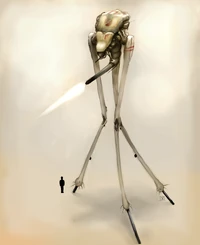
Concept very similar to the final version, dated 2001.
- Valve's Bill Fletcher used a giraffe/gorilla combo as animation reference for the Strider. He wanted the creature to capture the gracefulness of a giraffe and stomp and lead with its elbows like a gorilla when it walks, to convey a simian power.[2]
- During the development of Half-Life 2, developers were also working on the Crab Synth's concept art and designed the Attack Synth where its legs look very similar to the strider's but more thick.
- At some point in Half-Life 2’s development, the Strider was white, like the Combine Super Soldier, the Combine Assassin or the Overwatch Elite.[2]
- Early concepts depict the Strider with different heads, such as one only consisting of a cannon.[2]
- Several early iterations also bore miscellaneous markings, notably a maroon circle with a "Z" or a lightning bolt in the middle, and some sort of L with a small dot in the opposite angle.[2]
- It was originally to be met in the Coast levels, at least near the Air Exchange.[2]
- According to one of the concept art pictures featured in Raising the Bar, the Strider's current design was already defined as early as in 2001 (as seen in the date in Ted Backman's signature).[2]
- As seen in the Half-Life 2 Beta source code, the Hopwire Grenade was originally to be the weapon of choice against Striders,[3] replaced in Episode Two by the Magnusson Device. This is confirmed in the Episode Two commentary, in which Valve's Joshua Weier states that the Magnusson Device "started life as a Half-Life 2 weapon called the Hopwire".[4]
- As seen in the playable Half-Life 2 Beta, it was at some point possible for the player to assault Striders, ride them and take their gun after killing them. Noclipping to the Strider's head, then pressing the Use key results in the player seeing through the creature's eyes. At that point the only thing to do to free oneself is to kill the creature, for instance with the RPG (as the only way to kill a Strider in the playable Half-Life 2 Beta is by standing inside its head), or reload the game. When killing it, the Strider collapses, releasing the player. At that point, the red ERROR model appears. When walking through it, the player acquires the Immolator. This suggests the Immolator acts here as a placeholder for the Strider's warp cannon, and that rescuing it was at some point considered, a role that the Combine Guard Gun was already filling. As a side note, the Immolator worldmodel exists and should appear instead of the ERROR model.
- The Strider appears in two E3 maps, "
e3_strider" and "e3_c17_02". In the first map, several Striders were to chase gas mask Rebels through ruined streets, and one of the Striders was to destroy an arch building.[5] In the other map, more recent, similar events were to occur, with a tram passing by in the middle of the road. The reused arch building was also to be destroyed the same way. Parts of "e3_c17_02" were reused in "d3_c17_07" (the arch building) and "d3_c17_13" (the street, the tram tracks and the shelter).
- The Strider is an indirect successor to the Combine Super Soldier.[2]
- The cut Combine Guard Gun is a similar weapon to the Strider's cannon (it was also to be used against Striders, according to the leaked game source code); the cut Vortex Hopwire also produces similar effects. The cut Black Hole Gun, originally designed for Quiver, is also similar.
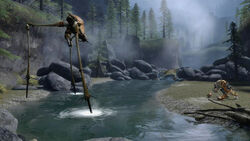
Dog challenging the Strider in the Episode Two trailer.
- In the Episode Two commentary, information is given about the spectacular battle between Dog and the Strider:
- According to Valve's Ken Birdwell, the Strider for the sequence with Dog was custom built, with large portions of it capable of being ripped off, and "goo" being spewed everywhere when it took damage. The custom Strider was used as a test bed for new modeling technology and Valve's new particle system introduced in Episode Two. Ken further adds that with the episodic production process of the HL games, a lot of new technology comes online throughout development. Since any new technology takes a year or more to really work out all the bugs, developers like to look for isolated areas - like this one - where they can test out new things without risking other elements of the game which they already know to be fully functional. Valve followed this same process with HDR in Lost Coast; once they were sure that new in-engine additions did not break anything, they were able to move the new features into general use. Since the new, custom iteration of the Strider performed well in the sequence with Dog in Episode Two, it will become the new Strider model used by Valve's development team as they move forward, and any new knowledge gained will be applied to new monsters in Episode Three.[4]
- Bill Fletcher adds that their main goal with that scene was to create "a cinematic battle of the titans", Dog vs. a Strider. While they were excited with the early implementations, it became obvious that players were uncertain of their role in the scene. Originally the confrontation built slowly with Dog squaring off against the Strider, but having such a slow beginning proved problematic. It looked good in the Episode Two trailer, but did not play well in the game. Instead of the slow build, the team decided to send Dog straight into action. He makes a grand entrance, jumps on the Strider and the fight begins. The quick start helps to grab the players attention instead of giving them too much time to worry about what they should be doing.[4]
- According to John Guthrie, the massive Strider battle near White Forest was in production longer than any other map in Episode Two. Tuning it required many, many months of testing and iteration to address playtest feedback, and this was complicated by the fact that every time the team playtested, they saw individuals adopt completely different approaches to defeating the Striders. Some threw logs at Hunters; others relied on their Rebel companions to kill them. Some players never sprinted, while others never used the car. They tried to keep supporting all the different strategies that occurred to players, so that their experiments with tactics would be rewarding rather than frustrating. Meanwhile, they had to make sure the Strider and Hunter behaviors were consistent, and balance the experience so that it would be a satisfying game experience for all different play styles at every skill level.[4]
- According to a comment section in Half-Life 2's source code, the Strider originally had a bug where its pulse cannon's damage per shot to NPCs was based directly on the ammo capacity (15), when it was assumed that original damage was 8. This was fixed in an update and finally fixed in Episode One. When shipping The Orange Box, the Strider's ammo was changed to 15 for Half-Life 2 and 5 for Episode Two.[6]
- The Strider battle in Half-Life: Alyx originates from a circa-2015 playtest where players were simply placed underneath a Half-Life 2-Strider. Satisfied that a Strider battle in VR would make for a worthwhile experience, the developers played with different ways of having the Strider stalk the player, be it shooting through cover or breaking through a wall.
- The scene of the two Combine soldiers investigating the de-activated Strider is designed to hint to the players the Strider may not actually be dead.
- Despite outward appearances, the Strider battle was originally designed around the idea of having the player cooperate with the Strider: in order to progress, the Player needs the Strider's help to clear obstacles, using the childrens' story The Lion and the Mouse as a metaphor. Most of this, along with an early idea of the Strider being trapped under an elevator before being freed, was cut although The Lion and the Mouse concept is still loosely used in the final game.
Related achievements[]
Half-Life 2[]

|
| ||
| Survive the rooftop Strider battle in the ruins of City 17. |
Half-Life 2: Episode Two[]

|
| ||
| Save all buildings outside the missile silo from destruction. |

|
| ||
| Save the missile silo from the Combine offensive. |
Half-Life: Alyx[]

|
| |
Earned after waking the Strider in chapter 10: Breaking and Entering.
|
Trivia[]
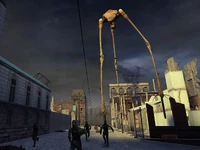
Gas mask Rebels fleeing a Strider in the map "e3_strider", in one of the earliest Half-Life 2 screenshots.
- The only way to spawn a Strider via the console is to activate "noclip", going up to at least the creature's height, and typing into the console "give npc_strider". It will not use its warp cannon and will only walk if the target moves out of its line of sight and if the map has the necessary node structure.
- Striders closely resemble the "tripods" described in H.G. Wells' The War of the Worlds, especially the warping cannon, which is very similar to the Heat-Ray from the aforementioned novel. Earlier Strider concept art further exemplifies the similarities. Just like the tripods, they make strange, beeping noises.
- The accuracy and rate of fire of the Strider's pulse turret was increased in Episode One but has decreased damage.
- According to the developer commentary, the behavior of the pulse turret is slightly modified to allow the player to fire a rocket at the Strider without taking damage. The Strider will fire a few moments then pause for a brief period, long enough for the player to guide the rocket to the Strider.
- The Strider has a strange method of firing with its pulse cannon, a variation of walking (that is, firing at a point near a target and slowly aiming towards it). It seems that when it focuses on a particular enemy, it fires a long string of shots: the first ones do not hit, but unless the enemy goes behind cover, the last few will always hit. However, this has been removed in Episode One, notably in the final Strider battle.
- An Orange Box Achievement, "Giant Killer", requires surviving the Strider battle at the end of the Half-Life 2 chapter "Follow Freeman!". The Episode Two Achievements are "Neighborhood Watch" and "Defensive of the Armament". They involve saving all the buildings outside White Forest and preventing the Striders from reaching the base, respectively.
- Gunships and Striders bear the same logo on their back and head, respectively. This logo was on the back of the Overwatch Soldier's old skin (in white) and can also be seen on the shoulder of one of the Combine Synth Elite Soldier versions. Its meaning and whether it is a Combine logo or not or if it proves a closer relation between the Gunship and the Strider are unknown.
- If Gordon fails to defeat all the Striders attacking White Forest, the last one will destroy the antenna in a single shot. Afterward, the message "The rocket has been destroyed - Magnusson's misgivings about the Freeman are completely justified. - The game now ends" is shown, and the game reloads.
- If a player playing Half-Life 2 uses cheat codes and fires a rocket at the Strider which walks past the opening square in City 17, the rocket will harm the Strider - however it will turn towards the player and glare for a moment before moving on. This also applies in Episode One after the underground.
- Knowing the Strider's offensive capabilities, they may have been used by the Combine during the Seven Hour War, possibly a more heavily armored variation.
- The Strider can be also heard in the ambience sounds, most notably "streetwar".
- In Half-Life 2 and its Episodes, Striders never use their legs to kill the player. However, if played in Garry's Mod, and the player gets too close, they will kill using their long legs (only the Striders that are spawned by the map, not the ones spawned by the players). Getting in the Strider's way may still result in death by stomping, however.
- This ability is shown and used during part of E3 2003.
Gallery[]
Concept art[]
Screenshots[]
Pre-release[]
e3_end" and "hazard01".Half-Life 2[]
Episode One[]
Episode Two[]
List of appearances[]
- Half-Life 2 (First appearance)
- Half-Life 2: Raising the Bar
- Half-Life 2: Episode One
- Source Particle Benchmark (Game files only) (Non-canonical appearance)
- Half-Life 2: Episode Two
- Half-Life: Alyx
References[]
- ↑ Half-Life 2 Prima Guide
- ↑ 2.0 2.1 2.2 2.3 2.4 2.5 2.6 2.7 2.8 Half-Life 2: Raising the Bar
- ↑ Half-Life 2 Beta source code
- ↑ 4.0 4.1 4.2 4.3 4.4 Half-Life 2: Episode Two commentary
- ↑ Half-Life 2 E3 2003 Trailer
- ↑ Half-Life 2 source code



